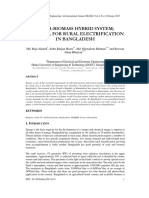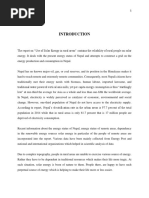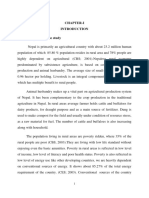A Study On Domestic Energy Consumption in Rural, Semi-Urban and Urban Sectors of Jorhat District: Assam
A Study On Domestic Energy Consumption in Rural, Semi-Urban and Urban Sectors of Jorhat District: Assam
Uploaded by
Amit GhadeCopyright:
Available Formats
A Study On Domestic Energy Consumption in Rural, Semi-Urban and Urban Sectors of Jorhat District: Assam
A Study On Domestic Energy Consumption in Rural, Semi-Urban and Urban Sectors of Jorhat District: Assam
Uploaded by
Amit GhadeOriginal Description:
Original Title
Copyright
Available Formats
Share this document
Did you find this document useful?
Is this content inappropriate?
Copyright:
Available Formats
A Study On Domestic Energy Consumption in Rural, Semi-Urban and Urban Sectors of Jorhat District: Assam
A Study On Domestic Energy Consumption in Rural, Semi-Urban and Urban Sectors of Jorhat District: Assam
Uploaded by
Amit GhadeCopyright:
Available Formats
International Journal of Engineering Trends and Technology (IJETT) – Volume 30 Number 8 - December 2015
A Study on Domestic Energy Consumption in Rural, Semi-
urban and Urban Sectors of Jorhat District: Assam
Reeta Sarmah*, Dikshita Bhattacharyya**
* Mechanical Engineering Department, Jorhat Engineering College,
Jorhat-785007, Assam, India
** Mechanical Engineering Department, Jorhat Engineering College,
Jorhat-785007, Assam, India
ABSTRACT or fields as cooking fuel. Kerosene is used as
A study was conducted to analyse the household lighting fuel as the constant availability of
domestic energy consumption pattern of rural, semi- electricity is very poor in rural areas. The large scale
urban and urban sectors of Jorhat district of Assam. consumption of fuel wood causes the rapid depletion
The data collected regarding domestic energy of forest resources. Although rice is the main crop in
consumption and domestic fuel technology in rural, Assam, a huge amount of rice residues go waste due
semi urban and urban households were analysed. to lack of awareness of the rural masses about proper
The per capita kerosene consumption was found to utilisation of these as domestic fuels. Twelve
be 0.372 GJ per year and that of fuel wood per villages were sampled in Jorhat district of Assam to
capita was found to be 10.101 GJ per year. Per study the domestic energy consumption pattern.
capita electricity consumption was estimated at The semi- urban people use fuel wood, kerosene and
0.0029 GJ per year in rural domestic sector. The per LPG as cooking fuels and kerosene and electricity as
capita consumption of kerosene, fuel wood, LPG and space lighting fuels. The semi urban people buy fuel
kerosene was found to be 0.451 GJ per year, 0.762 wood that come from the rural areas. Almost all
GJ per year, 1.986 GJ per year and 0.578 GJ per people have to keep kerosene as an alternative for
year respectively in semi- urban sector. In the urban lighting as electricity failure is a regular
sector, kerosene consumption was found to be 0.221 phenomenon in these areas.
GJ per year and that of LPG and electricity was LPG is the main cooking fuel in urban sector of
found to be 2.321 GJ per year and 0.983 GJ per Assam and electricity is the main space lightning
year respectively. Use of fuel wood in urban sector fuel. Kerosene is kept as an alternative in some
was found to be nil. households to use for lightning purposes whenever
Keywords: Rural energy, per capita consumption, there is a power cut or load shedding. The urban
fuel wood, kerosene, LPG, electricity masses use electricity to run some household
1. INTRODUCTION electrical appliances and it is also used for cooking
The domestic consumption of fuel occupies in some households.
a large share in the national energy consumption in As not much studies have been conducted in the line
India. The non commercial and traditional sources of of domestic energy consumption in the north eastern
energy namely, fuel wood, dung and agricultural part of India[7], an attempt is made through this
residues constitute the main sources of domestic paper to compare domestic energy consumption in
energy in rural India, catering to the needs of about rural, semi-urban and urban sectors of Jorhat district
80 per cent of the households despite the of Assam.
availability of the commercial sources of energy[1],
fuel wood occupies a major position catering to the 2. MATERIALS AND METHODS
needs of about 56 per cent of the rural A stratified random sampling technique
households[2]. was used for selecting households as sample units.
The energy situations in India is varied in nature Based on the existing infrastructural facilities such
with varied physical and socio-economic as the condition of roads, availability of electricity,
scenarios[3]. For this, special understanding appears transportation, marketing facilities, LPG agencies,
to be a basic approach towards evolving area educational facilities, medical facilities etc., the
specific rural energy strategies[4,5]. three sectors were identified on the basis of the
Majority of the rural people in Assam which is distance required to traverse to avail these facilities,
situated in the north-eastern part of India, rely the three sectors in which 0-7 kilometre represents
basically on fuel wood collected from nearby forests the urban sector, greater than 7 kilometre represents
ISSN: 2231-5381 http://www.ijettjournal.org Page 389
International Journal of Engineering Trends and Technology (IJETT) – Volume 30 Number 8 - December 2015
semi-urban sector and greater than 15 kilometre converted into energy. One LPG cylinder for
represents rural sector. Sample of 450 households domestic use contains 14.2 kg of fuel and this
were chosen for rural households, 245 for semi converts to 624.8 MJ of energy. Finally, yearly
urban households and 215 fir urban households. consumption of LPG in cooking was found out.
The domestic energy sources and As most the sampled rural households
consumption pattern were obtained from every were unelectrified, the kerosene serves the purpose
household through a questionnaire. The survey data of space lighting in these households. In semi- urban
were collected at two levels- the sector and the sector, the people keep kerosene as an alternative for
household. The data were collected through personal space lighting when whenever there is a power cut
interview. Approximately 30 minutes time was taken or a power failure. Some of the urban people use
in filling up the questionnaire for each household. kerosene for cooking purposes. Data on volume
Two end uses mainly for cooking and consumption of kerosene per household were
space lightning were considered in the three sectors. converted into yearly energy consumption. Finally,
The information on cooking was sought on the type the energy consumption for the three sectors was
fuel and amount consumed per day per household. taken.
Data regarding consumption of fuel wood and Data collected on unit electricity
kerosene per day per household, unit of electricity consumption in kWh per month in the households of
consumption per month per household and the rural, semi urban and urban sectors were converted
number of LPG cylinders consumed per household into MJ (1 kWh = 3.6 MJ) and then the annual
per month were collected from the sampled families. electricity consumption per household was
Based on the feedback received the data estimated. The pattern of yearly electricity was
were modified into standard forms. The calorific obtained by adding total households for each sector.
value of fuel wood with 20% moisture content (air
dried) is 15 MJ per kg and that of kerosene is 44 MJ
per kg[4,7]. Also, calorific value of LPG is 35.2 MJ 3. RESULTS AND DISCUSSIONS
per cubic metre. 1 kW of electricity is equivalent to 3.1 Rural Domestic Sector
3.6 MJ. Table-1 depicts per capita per year
The yearly energy consumption was domestic energy consumption in rural, semi rural
found from conversion from the per day energy and urban sectors. Fuel wood serves the purpose of
consumption. For winter season i.e. from November cooking in 100% of rural households, kerosene and
to March, 40% excess of the daily fuel wood electricity are used for space lightning in rural
consumption was added in the calculation of annual households. The annual energy consumption in rural
consumption rate as most of the rural households sector for cooking with fuel wood was found to be
consume low quality fuel wood for warming up. The 57,737.32 GJ and per capita per year consumption to
energy consumption in a household was added to be 10.101 GJ. The yearly energy consumption from
obtain annual energy consumption rate of a sector. kerosene in this sector was estimated at 2126.35 GJ
LPG is commonly used as a cooking and per capita per year consumption was found to be
fuel in semi urban and urban areas. Data collected on 0.372 GJ.
number of cylinders per month per household were
TABLE 1: Comparison of Domestic Energy Consumption in Rural, Semi urban and Urban sectors of Jorhat District, Assam
Item Rural Semi urban Urban
Distance from the town >15 km >7 km 0-7 km
Population 5716 2465 2130
Use of kerosene 2126.35 GJ per year 1111.72 GJ per year 470.73 GJ per year
(0.372GJ/capita/year) (0.451 GJ/capita/year) (0.221 GJ/capita/year)
Use of fuel wood 57,737.32 GJ per year 1878.33 GJ per year NIL
(10.101 GJ/capita/year) (0.762 GJ/capita/year)
Use of LPG NIL 4895.49 GJ per year 4943.73 GJ per year
(1.986 GJ/capita/year) (2.321 GJ/capita/year)
Use of electricity 16.5764 GJ per year 1424.77 GJ per year 2093.79 GJ per year
(0.0029 GJ/capita/year) (0.578 GJ/capita/year) (0.983 GJ/capita/year)
ISSN: 2231-5381 http://www.ijettjournal.org Page 390
International Journal of Engineering Trends and Technology (IJETT) – Volume 30 Number 8 - December 2015
3.2 Semi urban Domestic Sector consumption was estimated at 1111.72 GJ and per
The annual consumption of fuel wood capita per year at 0.451 GJ. The yearly electricity
in cooking in semi- urban sector was estimated at consumption was found to be 1424.77 GJ and per
1878.33 GJ and per capita per year consumption has capita per year consumption to be 0.578 GJ.
been 0.762 GJ. About 30% of the semi urban people
use fuel wood as their cooking fuel. Also, some of 3.3 Urban Domestic Sector
the households keep fuel wood for use when there is The urban people do not use fuel wood
a shortage of LPG supply. in cooking. LPG serves as main cooking fuel in this
Most of the semi- urban people in semi sector. Kerosene is used by some of the households
urban sector rely on LPG for cooking and they for water heating. This consumption of LPG was
collect LPG cylinder from the local agencies or estimated at 4943.73 GJ annually and per capita per
from the town agencies. The annual LPG year consumption was estimated at 2.32 GJ.
consumption in this sector was estimated at 4895.49 Electricity is the prime lighting source in this sector.
GJ and per capita per year consumption was found Besides lighting, the urban people use electricity in
to be 1.986 GJ. many electrical appliances. In this sector, annual
As the semi urban sector is completely electricity consumption was found to be 2093.79 GJ
electrified, electricity is used as prime lighting and per capita per consumption to be 0.983 GJ. The
source. Most of the households use electrical yearly consumption of kerosene was estimated at
gadgets and appliances. The people of this sector 470.73 GJ and per capita per year consumption was
keep kerosene in stock to meet the need of lighting 0.221 GJ.
in regular power cut. The annual kerosene
Figure 1 depicts domestic energy consumption of different fuels in GJ/capita/year in the three
sectors under study.
12
10
Domestic Energy Consumption in GJ/Cap/Yr
8
Kerosene
6 Fuelwood
LPG
Electricity
4
0
Rural Semi-urban Urban
Fig.1: Comparison of Domestic Energy Consumption in Rural, Semi-urban and Urban Sectors of Jorhat District of Assam
4. CONCLUSIONS of using those as fuels. So, emphasis should be
A wide variations of domestic given to develop appropriate technology for proper
energy consumption pattern is evident in rural, utilisation of agricultural residues and dung. This
semi urban and urban sectors of Jorhat district of will be helpful in minimising deforestation and
Assam. Although the agricultural residues and upgrading quality of the rural life. Hence, there is a
animal dung are found in abundance in rural areas scope for energy conservation through appropriate
these are not used due to availability of forest fuel use of untapped energy sources available in the
resources and the lack of awareness and technology rural areas of Assam.
ISSN: 2231-5381 http://www.ijettjournal.org Page 391
International Journal of Engineering Trends and Technology (IJETT) – Volume 30 Number 8 - December 2015
REFERENCES
[1] Advisory Board of Energy(ABE). 1985. The Energy
Scene, Development of India, New Delhi, 71-92.
[2] National Council of Applied Economic
Research(NCAER). 1985. Domestic Fuel Survey with
Special Reference to Kerosene. Vol. I and II. New
Delhi: NCAER.
[3] National Institute of Rural Development. 1989.
Integrated Rural Energy Planning with Special
Reference to NE Region. Guwahati: North-Eastern
Regional Center.
[4] Ravindranath, N.H., and Hall, D.O. 1995. Biomass,
Energy and Environment: A Developing Country
Prospective from India. London: Oxford University
Press.
[5] Bose, Ranjan Kumar; Puri Charu: and Joshi Veena.
1991. Energy profiles of three unelectrified villages of
Uttar Pradesh of India. Biomass and Bio-energy. The
International Journal 1(2): 99-109.
[6] Mathew, T. 1987. North-eastern regional research
paper. In Rural Energy Planning for the Indian
Himalaya, 236-239. New Delhi: Willey Eastern Ltd.
[7] Patel, R.C., and Karmachandani, C.J. 1984. Fuels. In
Elements of Heat Engines, I: 136-138. S.I.: Acharya
Bool Depot- Baroda.
[8] Ms.S.Gowri, Mr. V. Harikrishnan. " Green Computing:
Analysing Power Consumption using Local Cooling",
International Journal of Engineering Trends and
Technology(IJETT), V15(3), 105-109 Sep 2014.
ISSN: 2231-5381 http://www.ijettjournal.org Page 392
You might also like
- Ice PlantDocument101 pagesIce PlantZa Yon100% (5)
- C9 Engine BrochureDocument6 pagesC9 Engine Brochurebaghermanesh135450% (2)
- Rural Energy Data Sources and Estimations in IndiaDocument22 pagesRural Energy Data Sources and Estimations in Indianenu_100No ratings yet
- 10 1016@j Energy 2019 06 048Document10 pages10 1016@j Energy 2019 06 048KEMESSO MOHAMEDNo ratings yet
- Department of Physics: Project ReportDocument13 pagesDepartment of Physics: Project ReportHang RashNo ratings yet
- Urban Energy Consumption in A City of Indonesia: General OverviewDocument15 pagesUrban Energy Consumption in A City of Indonesia: General OverviewAman GuptaNo ratings yet
- Direct and Indirect Energy Requirements of Households in IndiaDocument13 pagesDirect and Indirect Energy Requirements of Households in IndiaHitanshu SethiNo ratings yet
- Rural Electrification in The Changing Paradigm of Power Sector Reforms in IndiaDocument8 pagesRural Electrification in The Changing Paradigm of Power Sector Reforms in IndiaprosysscribdNo ratings yet
- BioenergyDocument16 pagesBioenergyVivek 2K21B241No ratings yet
- GIS Mapping Analysis of Energy Consumption PatternDocument12 pagesGIS Mapping Analysis of Energy Consumption Patternujjwalacharya2063No ratings yet
- Scope of Energy ConservationDocument5 pagesScope of Energy ConservationRishav HarshNo ratings yet
- Polygeneration For An Off-Grid Indian Village - Optimization by Economic and Reliability AnalysisDocument15 pagesPolygeneration For An Off-Grid Indian Village - Optimization by Economic and Reliability AnalysisSagar KumarNo ratings yet
- Sustainability 10 02841Document17 pagesSustainability 10 02841SterlingNo ratings yet
- American Journal of Engineering Research (AJER)Document7 pagesAmerican Journal of Engineering Research (AJER)AJER JOURNALNo ratings yet
- Bagmati Province EnergyDocument127 pagesBagmati Province EnergyutsavshreeNo ratings yet
- Boi Plocies Prospect IndiaDocument23 pagesBoi Plocies Prospect IndiaManvindra SinghNo ratings yet
- Agricultural Consumption of DieselDocument1 pageAgricultural Consumption of DieselAshutosh KumarNo ratings yet
- A Report On Energy, Its Production and Consumption in World and PakistanDocument5 pagesA Report On Energy, Its Production and Consumption in World and PakistanraowaleedahmadNo ratings yet
- IP UK Pine Needle Power Generation PDFDocument23 pagesIP UK Pine Needle Power Generation PDFSunny DuggalNo ratings yet
- Enhancing The Heating Properties of AgriDocument16 pagesEnhancing The Heating Properties of AgriBALOGUNNo ratings yet
- Bio MassDocument9 pagesBio MassEranga Nandana Kumara KudahewaNo ratings yet
- Energy Building ReportDocument6 pagesEnergy Building ReportSantosh SantuNo ratings yet
- 0 Singh 2018 Ownership of AppsDocument9 pages0 Singh 2018 Ownership of Appskmlhectorseth94No ratings yet
- Lalit Paper PubDocument9 pagesLalit Paper PubR K AggarwalNo ratings yet
- Novel Rural Biogas Plant For Decentralised Renewable EnergyDocument5 pagesNovel Rural Biogas Plant For Decentralised Renewable EnergySethumadhavan PadmanabhanNo ratings yet
- Gandhi Talk On RDDocument21 pagesGandhi Talk On RDsanjayNo ratings yet
- Full ReportDocument5 pagesFull ReportJohn Lordave JavierNo ratings yet
- 4115elelij01 PDFDocument11 pages4115elelij01 PDFFeby LailaniNo ratings yet
- A Report On An Overview of Renewable Energy Scenario and Its Share To The Total Energy Demand in NepalDocument45 pagesA Report On An Overview of Renewable Energy Scenario and Its Share To The Total Energy Demand in NepalIndra Kumar Maharjan67% (3)
- Rural HouseholdDocument7 pagesRural Householdshuchi745No ratings yet
- Elasticities of Electricity Demand in Urban Indian HouseholdsDocument8 pagesElasticities of Electricity Demand in Urban Indian HouseholdsNora AziriNo ratings yet
- 7 - Biogas Paper For Journal IISTEDocument10 pages7 - Biogas Paper For Journal IISTEiisteNo ratings yet
- Indian Energy ScenarioDocument17 pagesIndian Energy ScenarioTony StarkNo ratings yet
- Role of Solar Energy in Rural Areas of NepalDocument27 pagesRole of Solar Energy in Rural Areas of NepalSuman PoudelNo ratings yet
- Research Paper PDFDocument5 pagesResearch Paper PDFindranil somoNo ratings yet
- Estimation of Solar Panel Power For Irrigated Crops in Northern Gangetic PlainsDocument14 pagesEstimation of Solar Panel Power For Irrigated Crops in Northern Gangetic PlainsTJPRC PublicationsNo ratings yet
- The Environmental Effects of Rural Energy UseDocument15 pagesThe Environmental Effects of Rural Energy UsesubasratnaNo ratings yet
- Energy ConservationDocument42 pagesEnergy Conservationyaduvanshiy118No ratings yet
- Sustainable Electricity Generation in Rural Communities Using Hybrid Energy System: The Case Study of Ojataye VillageDocument14 pagesSustainable Electricity Generation in Rural Communities Using Hybrid Energy System: The Case Study of Ojataye VillageAhmad Danjuma MungaNo ratings yet
- Pengembangan Listrik Tenaga Biogas Skala Rumah Tangga Untuk Daerah Terpencil Di IndonesiaDocument16 pagesPengembangan Listrik Tenaga Biogas Skala Rumah Tangga Untuk Daerah Terpencil Di IndonesiaSari MurdayantiNo ratings yet
- Electrical Energy Consumption in Over Exploited Regions of East Godavari DistrictDocument7 pagesElectrical Energy Consumption in Over Exploited Regions of East Godavari DistrictsunilkumareceNo ratings yet
- Biomass PDFDocument23 pagesBiomass PDFMunish SinghNo ratings yet
- Rice Husk StoveDocument9 pagesRice Husk StoveswordprakashNo ratings yet
- Biofuels of IndiaDocument18 pagesBiofuels of IndiaNishant GuptaNo ratings yet
- 10.11648.j.ajee.20210901.111Document8 pages10.11648.j.ajee.20210901.111Ricardo Alberto LopezNo ratings yet
- Case Study On Distributed Decentralised Generation Based Biomass Gasifier System at JAMERA (District Korba), ChhattisgarhDocument25 pagesCase Study On Distributed Decentralised Generation Based Biomass Gasifier System at JAMERA (District Korba), ChhattisgarhMAX PAYNENo ratings yet
- Enhancement of Energy Efficiency in Wastewater Treatment PlantsDocument8 pagesEnhancement of Energy Efficiency in Wastewater Treatment PlantsInternational Journal of Innovative Science and Research TechnologyNo ratings yet
- FAFD 53. Biomass Energy Strategy ASEAN 2020 2030 Final Draft 210820Document16 pagesFAFD 53. Biomass Energy Strategy ASEAN 2020 2030 Final Draft 210820Zul SallehNo ratings yet
- Fuelwood ReportDocument16 pagesFuelwood Reportskatfri326No ratings yet
- Non Conventional Sources of EnergyDocument45 pagesNon Conventional Sources of EnergyLakshumu Naidu AnnepuNo ratings yet
- Dave and MaheshDocument5 pagesDave and Maheshbentarigan77No ratings yet
- Alleviating Energy Poverty Through Innovation: The Case of Jyotigram Yojana (Rural Lighting Scheme) of GujaratDocument12 pagesAlleviating Energy Poverty Through Innovation: The Case of Jyotigram Yojana (Rural Lighting Scheme) of GujaratSatyajitMohapatraNo ratings yet
- Energies: Study On The Potential of Rice Straws As A Supplementary Fuel in Very Small Power Plants in ThailandDocument21 pagesEnergies: Study On The Potential of Rice Straws As A Supplementary Fuel in Very Small Power Plants in Thailandgoel2001No ratings yet
- Renewable Energy: The Key To Achieving Sustainable Development of Rural BangladeshDocument7 pagesRenewable Energy: The Key To Achieving Sustainable Development of Rural BangladeshRafid RahmanNo ratings yet
- A REPORT On Physic - Docx Sweta SharmaDocument15 pagesA REPORT On Physic - Docx Sweta Sharmasangamkarki214No ratings yet
- Expanding Access To Modern Energy in Rural India: Dr. P. BalachandraDocument51 pagesExpanding Access To Modern Energy in Rural India: Dr. P. BalachandraRavi BhadaniNo ratings yet
- Energy Policy: T.K. Baul, D. Datta, A. AlamDocument11 pagesEnergy Policy: T.K. Baul, D. Datta, A. Alamfahim asifNo ratings yet
- Biogas For Rural Communities: TD390 Supervised Learning: Study ReportDocument52 pagesBiogas For Rural Communities: TD390 Supervised Learning: Study ReportTanvi ChemburkarNo ratings yet
- Biomass Power Plant Market in IndiaDocument3 pagesBiomass Power Plant Market in Indiavenug4No ratings yet
- Chapter PageDocument58 pagesChapter Pagesaradupadhyay5No ratings yet
- Potential of Bioethanol As A Household Fuel For Middle-Income Urban Kenya: A Case Study of Nairobi CityDocument13 pagesPotential of Bioethanol As A Household Fuel For Middle-Income Urban Kenya: A Case Study of Nairobi CityCatalina Camargo AngaritaNo ratings yet
- Swachh Railway StationDocument45 pagesSwachh Railway StationAmit GhadeNo ratings yet
- 22661-Sample-Question-Paper (Msbte Study Resources) PDFDocument4 pages22661-Sample-Question-Paper (Msbte Study Resources) PDFAmit Ghade100% (2)
- 9.optimisation in Design of Mechanical Scissor LiftDocument5 pages9.optimisation in Design of Mechanical Scissor LiftAmit GhadeNo ratings yet
- Ijet16 08 01 085 PDFDocument11 pagesIjet16 08 01 085 PDFAmit GhadeNo ratings yet
- Union Performance EnvironmentDocument13 pagesUnion Performance EnvironmentAmit GhadeNo ratings yet
- 17331Document20 pages17331Amit GhadeNo ratings yet
- Important Instructions To Examiners:: Model AnswerDocument18 pagesImportant Instructions To Examiners:: Model AnswerAmit GhadeNo ratings yet
- Ref ComponentsDocument23 pagesRef ComponentsAmit GhadeNo ratings yet
- 17505Document18 pages17505Amit GhadeNo ratings yet
- Important Instructions To Examiners:: (Autonomous)Document23 pagesImportant Instructions To Examiners:: (Autonomous)Amit GhadeNo ratings yet
- Blutooth Chat Project ReportDocument58 pagesBlutooth Chat Project ReportDeven Rathore57% (7)
- Polity Set 1Document42 pagesPolity Set 1Manish ChoudharyNo ratings yet
- 2nd Semester Sylabus Pondicherry UniversityDocument6 pages2nd Semester Sylabus Pondicherry UniversityirinmichaelNo ratings yet
- Contract Labour (Regulation and Abolition) Act, 1970Document140 pagesContract Labour (Regulation and Abolition) Act, 1970retika yadavNo ratings yet
- MIDTERM ASSIGNMENT Magdalino James Francis 1ST YEAR 2 BSTMDocument13 pagesMIDTERM ASSIGNMENT Magdalino James Francis 1ST YEAR 2 BSTMJames Francis MagdalinoNo ratings yet
- PSALM v. CIR (2017)Document3 pagesPSALM v. CIR (2017)PiaNo ratings yet
- East Vs West Cultural DifferencesDocument2 pagesEast Vs West Cultural DifferencesJawid WakmanNo ratings yet
- Address Resolution Protocol (ARP)Document11 pagesAddress Resolution Protocol (ARP)fortunatesanjibNo ratings yet
- ABFL - KID - NCD - 08 August 2024 - SignedDocument96 pagesABFL - KID - NCD - 08 August 2024 - Signedstepper1133No ratings yet
- Mines and Minerals Development (General) Regulations 2016 PDFDocument109 pagesMines and Minerals Development (General) Regulations 2016 PDFChristine SakalaNo ratings yet
- How To Fix Explorer - Exe Problem in Windows XP When Taskbar Disappears - EhowDocument4 pagesHow To Fix Explorer - Exe Problem in Windows XP When Taskbar Disappears - EhowqqwwqqwqwNo ratings yet
- August 13 Validated Online and Mail Applicants Pmaee 2019Document240 pagesAugust 13 Validated Online and Mail Applicants Pmaee 2019Alden Roi100% (1)
- System Requirements & Settings ManualDocument14 pagesSystem Requirements & Settings ManualfaisalNo ratings yet
- Common Problems in Taking Home Economics Strand 123Document40 pagesCommon Problems in Taking Home Economics Strand 123Will RodriguezNo ratings yet
- Material RequirementDocument37 pagesMaterial RequirementHarish ApNo ratings yet
- Morano Versus VivoDocument18 pagesMorano Versus VivoAnskee TejamNo ratings yet
- Quality Control RequirementsDocument37 pagesQuality Control RequirementsAhmed KarimNo ratings yet
- Course OutlineDocument7 pagesCourse OutlineBart LuceñaNo ratings yet
- G 1.2 2003 Design Drawing Presentation GuidelinesDocument23 pagesG 1.2 2003 Design Drawing Presentation GuidelinesAndresNo ratings yet
- Day 1 Advanced IDM-ERDDocument58 pagesDay 1 Advanced IDM-ERDThomas DuNo ratings yet
- Balance Sheet of DR Reddys Laboratories: - in Rs. Cr.Document14 pagesBalance Sheet of DR Reddys Laboratories: - in Rs. Cr.Anand MalashettiNo ratings yet
- Order Overview: Contact Address Contact Information IKEA Contact InformationDocument7 pagesOrder Overview: Contact Address Contact Information IKEA Contact InformationneethukNo ratings yet
- Harness the Power of Finite Element Analysis - Table of ContentsDocument9 pagesHarness the Power of Finite Element Analysis - Table of ContentsKaustubh ChaudhariNo ratings yet
- IIR Filter-Sofyan AhmadiDocument9 pagesIIR Filter-Sofyan AhmadiyudiNo ratings yet
- Critical Reflection INDIVIDUAL-Marking CriteriaDocument3 pagesCritical Reflection INDIVIDUAL-Marking CriteriaRavi TejaNo ratings yet
- PenisDocument20 pagesPenisbingothecarrotNo ratings yet
- Class 12 Competency Based Question - Computer Science Chap 8 (2024-25)Document25 pagesClass 12 Competency Based Question - Computer Science Chap 8 (2024-25)haarithali123321No ratings yet


































































































